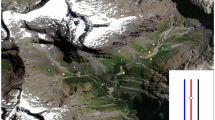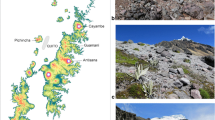Abstract
A major knowledge gap exists in understanding dispersal potential of ground-dwelling arthropods, especially in forest ecosystems. Movement of the ground-dwelling arthropod community was quantified using a novel mark-capture technique in which three different colored fluorescent powders in two separate mixtures were applied to the floor of a deciduous forest in concentric bands 3, 8, and 15 m from the center of 30 × 30 m experimental plots. The majority (67.1%) of ground-dwelling arthropods did not cross a colored band when fluorescents were mixed with protein powder in 2014. However, when mixed with sand in 2015, 77.3% of captured arthropods were marked with fluorescent powder, with the majority of individuals crossing one band (41.2%), suggesting limited dispersal by most individuals in the community. Only 2.8% and 15.0% of arthropods crossed all three bands in 2014 and 2015, respectively, which further indicates that individuals have limited dispersal. Responses were taxon-specific, and a high proportion of some arthropods such as millipedes and harvestmen crossed two or three bands. Limited dispersal by most individuals may have important implications for the structure and distribution of ground-dwelling arthropod communities, as well as their responses to natural or anthropogenic disturbances. Our results demonstrate the feasibility of this novel technique for self-marking and capturing individuals in the field to investigate dispersal of ground-dwelling arthropods.





Similar content being viewed by others
References
Adams J (1984) The habitat and feeding ecology of woodland harvestmen (Opiliones) in England. Oikos 42:361–370
Bowne DR, Bowers MA (2004) Interpatch movements in spatially structured populations: a literature review. Landsc Ecol 19:1–20
Brouwers NC, Newton AC (2009) Movement rates of woodland invertebrates: a systematic review of empirical evidence. Insect Conservation and Diversity 2:10–22
Clobert J, Danchin E, Dhondt AA, Nichols JD (eds) (2001) Dispersal. Oxford University Press, New York
Coleman DC, Crossley DA Jr, Hendrix PF (2004) Fundamentals of soil ecology. Academic, San Diego
Coviella CE, Garcia JF, Jeske DR, Redak RA, Luck RF (2006) Feasibility of tracking within-field movements of Homalodisca coagulata (Hemiptera: Cicadellidae) and estimating its densities using fluorescent dusts in mark–release–recapture experiments. J Econ Entomol 99:1051
David J-F (2009) Ecology of millipedes (Diplopoda) in the context of global change. Soil Organisms 81:719–733
De Souza AR, Ribeiro B, José N, Prezoto F (2012) Paint marking social wasps: an evaluation of behavioral effects and toxicity. Entomologia Experimentalis Et Applicata 144:244–247
Dodds KJ, Ross DW (2002) Sampling range and range of attraction of Dendroctonus pseudotsugae pheromone-baited traps. The Canadian Entomologist 134:343–355
Graham HM, Mangum CL (1971) Larval diets containing dyes for tagging pink bollworm moths internally. J Econ Entomol 64:376–379
Haagsma K, Rust M (1993) Two marking dyes useful for monitoring field populations of Reticulitermes hesperus (Isoptera: Rhinotermitidae). Sociobiology 25:155–164
Hagler JR, Jackson CG (2001) Methods for marking insects: current techniques and future prospects. Annu Rev Entomol 46:511–543
Hagler JR, Jones VP (2010) A protein-based approach to mark arthropods for mark-capture type research. Entomologia Experimentalis Et Applicata 135:177–192
Hogsette JA (1983) An attractant self-marking device for marking field populations of stable flies with fluorescent dusts. J Econ Entomol 76:510–514
Horton DR, Jones VP, Unruh TR (2009) Use of a new immunomarking method to assess movement by generalist predators between a cover crop and tree canopy in a pear orchard. Am Entomol 55:49–56
Jones VP, Hagler JR, Brunner JF, Baker CC, Wilburn TD (2006) An inexpensive immunomarking technique for studying movement patterns of naturally occurring insect populations. Environ Entomol 35:827–836
Jones VP, Melton TD, Baker CC (2011) Optimizing immunomarking systems and development of a new marking system based on wheat. J Insect Sci 11(87):1–16
Jønsson KA, Tøttrup AP, Borregaard MK, Keith SA, Rahbek C, Thorup K (2016) Tracking animal dispersal: from individual movement to community assembly and global range dynamics. Trends Ecol Evol 31:204–214
Lövei GL, Sunderland KD (1996) Ecology and behavior of ground beetles (Coleoptera: Carabidae). Annu Rev Entomol 41:231–256
Mascanzoni D, Wallin H (1986) The harmonic radar: a new method of tracing insects in the field. Ecological Entomology 11:387–390
Muir LE, Kay BH (1998) Aedes aegypti survival and dispersal estimated by mark-release-recapture in northern Australia. AmJTrop Med Hyg 58:277–282
Murphy SJ, Audino LD, Whitacre J, Eck JL, Wenzel JW, Queenborough SA, Comita LS (2015) Species associations structured by environment and land-use history promote beta-diversity in a temperate forest. Ecology 96:705–715
Musgrave AJ (1950) A note on the dusting of crops with fluorescein to mark visiting bees. The Canadian Entomologist 82:195–196
Narisu J, Lockwood A, Schell SP (1999) A novel mark-recapture technique and its application to monitoring the direction and distance of local movements of rangeland grasshoppers (Orthoptera: Acrididae) in the context of pest management. J Appl Ecol 36:604–617
Nazni W, Luke H, Wan Rozita W, Abdullah A, Sa’diyah I, Azahari A, Zamree I, Tan S, Lee H, Sofian M (2005) Determination of the flight range and dispersal of the house fly, Musca domestica (L.) using mark release recapture technique. Trop Biomed 22:53–61
Neuhauser EF, Hartenstein P (1978) Phenolic content and palatability of leaves and wood to soil isopods and diplopods. Pedobiologia 18:99–109
Niemelä J (2001) Carabid beetles (Coleoptera: Carabidae) and habitat fragmentation: a review. European Journal of Entomology 98:127–132
Ranjha MH, Irmler U (2014) Movement of carabids from grassy strips to crop land in organic agriculture. J Insect Conserv 18:457–467
Reigada C, Schreiber SJ, Altermatt F, Holyoak M (2015) Metapopulation dynamics on ephemeral patches. Am Nat 185:183–195
Reinecke J (1990) A rapid and controllable technique for surface labeling boll weevils with fluorescent pigments. Southwestern Entomologist 15(3):309–316
Rieske LK, Raffa KF (1990) Dispersal patterns and mark-and-recapture estimates of two pine root weevil species, Hylobius pales and Pachylobius picivorus (Coleoptera: Curculionidae), in christmas tree plantations. Environ Entomol 19:1829–1836
SAS (2014–2016) SAS Institute Inc. Version 9.3. Cary
Shear WA (1999) Key to milliped families of the eastern United States. Hampden-Sydney, Hampden-Sydney College, pp 1–34
Sivakoff FS, Jones SC, Machtley SA, Hagler JR (2016) Protein self-marking by ectoparasites: a case study using bed bugs (Hemiptera: Cimicidae). J Med Entomol 2016:1–8
Sivakoff FS, Rosenheim JA, Hagler JR (2012) Relative dispersal ability of a key agricultural pest and its predators in an annual agroecosystem. Biol Control 63:296–303
Southwood TRE (1962) Migration of terrestrial arthropods in relation to habitat. Biol Rev 37:171–211
Stern VM, Mueller A (1968) Techniques of marking insects with micronized fluorescent dust with especial emphasis on marking millions of Lygus hesperus for dispersal studies. J Econ Entomol 61:1232–1237
Thiele H-U (1977) Carabid beetles in their environments: a study on habitat selection by adaptations in physiology and behavior. Springer-Verlag, Berlin
Triplehorn CA, Johnson NF (2005) Borror and DeLong's introduction to the study of insects, 7th edn. Thomson Brooks/Cole, Belmont
Wallin H, Ekbom BS (1988) Movements of carabid beetles (Coleoptera: Carabidae) inhabiting cereal fields: a field tracing study. Oecologia 77:39–43
Wojcik DP, Burges RJ, Blanton CM, Focks DA (2000) An improved and quantified technique for marking individual fire ants (Hymenoptera: Formicidae). The Florida Entomologist 83:74–78
Acknowledgements
We thank A. Vargas-Loyo, K. Taylor, P. Snyder, C. Bonilla-Sanchez, C. Granger, D. Hartzler, V. Gauthier, A. Wade, N. Sharpe, (The Ohio State University), S. Ankney, E. Thorne, K. Curtin, G. Petree IV (Powdermill Nature Reserve) for assistance in the field and laboratory. D. Ross for generously providing the fluorescent powder. P. Curtin for permission to use her photographs taken in the field. C. Lindsay (Powdermill Nature Reserve) for facilitating access to lodging and field sites. Two anonymous reviewers provided helpful comments that improved the manuscript. Funding for this research was provided by state and federal funds appropriated to the Ohio Agricultural Research and Development Center and The Ohio State University.
Author information
Authors and Affiliations
Corresponding author
Rights and permissions
About this article
Cite this article
Perry, K.I., Wallin, K.F., Wenzel, J.W. et al. Characterizing Movement of Ground-Dwelling Arthropods with a Novel Mark-Capture Method Using Fluorescent Powder. J Insect Behav 30, 32–47 (2017). https://doi.org/10.1007/s10905-017-9598-0
Revised:
Accepted:
Published:
Issue Date:
DOI: https://doi.org/10.1007/s10905-017-9598-0




